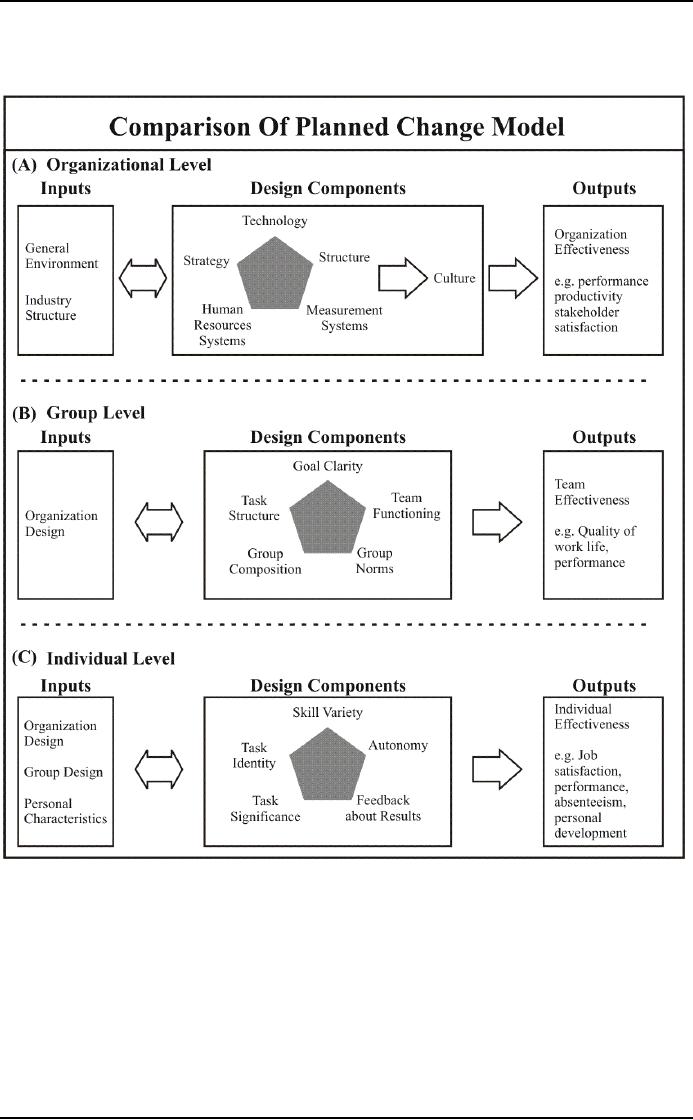 |
Diagnosing Organizations:Outputs, Alignment, Analysis |
| << Organization as Open Systems:Equifinality, Diagnosing Organizational Systems |
| Diagnosing Groups and Jobs:Design Components, Outputs >> |

Organization
Development MGMT
628
VU
Lesson
17
Diagnosing
Organizations
Fig
23: Comprehensive Model for
Diagnosing Organizational
Systems
Organization-Level
Diagnosis:
Design
Components:
Figure
23(A) shows that a strategic
orientation is composed of five major
design components--strategy,
technology,
structure, measurement systems,
and human resources
systems--and an intermediate
output--
culture.
Effective organizations align their
design components to each
other and to the
environment.
A
strategy represents the way an
organization uses its resources
(human, economic, or technical) to
gain
and
sustain a competitive advantage. It
can be described by the organization's
mission, goals and
objectives,
strategic
intent, and functional
policies. A mission statement
describes the long-term purpose of
the
organization,
the range of products or services
offered, the markets to be served,
and the social needs
served
by the organization's existence. Examples
are
"To
make people
happy."
...Walt
Disney
"To
give ordinary folk the
chance to buy the same
thing as rich people." ..... Wal
Mart

Organization
Development MGMT
628
VU
"To
preserve and improve human life.
"
...Merck
"To
give unlimited opportunity to
women." ....Mary Kay
Cosmetics
Goals
and objectives are
statements that provide
explicit direction, set organization
priorities, provide
guidelines
for management decisions,
and serve as the cornerstone
for organizing activities, designing
jobs,
and
setting standards of achievement.
Goals and objectives should
set a target of achievement
(such as 50-
percent
gross margins, an average
employee satisfaction score of
four on a five-point scale, or
some level of
productivity);
provide a means or system
for measuring achievement;
and provide a deadline or
timeframe
for
accomplishment. A strategic intent is a
succinct label that describes
how the organization intends to
achieve
its goals and objectives.
For example, an organization can
achieve goals through
differentiation of
its
product or service, by achieving the
lowest costs in the industry, or by
growth. Finally,
functional
policies
are the methods, procedures,
rules, or administrative practices that
guide decision making
and
convert
plans into actions. In the
semiconductor business, for
example, Intel has a policy
of allocating
about
30 percent of revenues to research
and development to maintain its lead in
microprocessors
production.
Technology
is concerned with the way an organization
converts inputs into products
and services. It
represents
the core of the transformation function
and includes production
methods, work flow,
and
equipment.
Automobile companies have
traditionally used an assembly-line
technology to build cars
and
trucks.
Two features of the technological core
have been shown to influence
other design
components:
interdependence
and uncertainty. Technical interdependence
involves ways in which the
different parts of a
technological
system are related. High
interdependence requires considerable
coordination among
tasks,
such
as might occur when departments
must work together to bring
out a new product.
Technical
uncertainty
refers to the amount of information
processing and decision making required
during task
performance.
Generally, when tasks require high
amounts of information processing
and decision making,
they
are difficult to plan and
routinize. The technology of car
manufacturing is relatively certain
and
moderately
interdependent. As a result, automobile
manufacturers can specify in
advance the behaviors
workers
should perform and how their
work should be coordinated.
The
structural system describes
how attention and resources
are focused on task
accomplishment. It
represents
the basic organizing mode chosen to
(1) divide the overall work
of an organization, into subunits
that
can assign tasks to
individuals or groups and
(2) coordinate these subunits
for completion of the
overall
work. Structure, therefore, needs to be
closely aligned with the organization's
technology.
Two
ways of determining how an organization divides
work are to examine its
formal structure or to
examine
its level of differentiation and
integration. Formal structures divide
work by function
(accounting,
sales,
or production), by product or service
(Chevrolet, Buick, or Pontiac), or by some
combination of both
(a
matrix composed of functional
departments and product
groupings). The second way
to describe how
work
is divided is to specify the amount of
differentiation and integration
there is in a structure. Applied
to
the
total organization, differentiation
refers to the degree of similarity or difference in
the design of two or
more
subunits or departments. In a highly
differentiated organization, there are
major differences in design
among
the departments. Some departments
are highly formalized with
many rules and regulations,
others
have
few rules and regulations,
and still others are
moderately formal or
flexible.
The
way an organization coordinates the work
across subunits is called
integration. Integration can
be
achieved
in a variety of ways--for example, by
using plans and schedules;
using budgets; assigning
special
roles,
such as project managers, liaison
positions, or integrators; or creating
cross-departmental task
forces
and
teams. The amount of integration required
in a structure is a function of (1) the
amount of uncertainty
in
the environment, (2) the level of
differentiation in the structure, and
(3) the amount of interdependence
among
departments. As uncertainty, differentiation,
and interdependence increase,
more sophisticated
integration
devices are required.
Measurement
systems are methods of
gathering, assessing, and
disseminating information on the
activities
of
groups and individuals in
organizations. Such data
tell how well the organization is
performing and are
used
to detect and control deviations
from goals. Closely related
to structural integration,
measurement
systems
monitor organizational operations and
feed data about work
activities to managers and
members
so
that they can better understand current
performance and coordinate work.
Effective information
and
control
systems clearly are linked
to strategic objectives; provide
accurate, understandable and
timely
information;
are accepted as legitimate by organization
members; and produce benefits in
excess of their
cost.
Human
resources systems include mechanisms
for selecting, developing, appraising,
and rewarding
organization
members. These influence the mix of
skills, personalities, and
behaviors of organization
members.
The strategy and technology
provide important information
about the skills and
knowledge
required
if the organization is to be successful. Appraisal
processes identify whether those
skills and
knowledge
are being applied to the work, and
reward systems complete the
cycle by recognizing

Organization
Development MGMT
628
VU
performance
that contributes to goal achievement.
Reward systems may be tied
to measurement systems so
that
rewards are allocated on the
basis of measured
results.
Organization
culture is the final design component. It
represents the basic assumptions,
values, and norms
shared
by organization members. Those cultural
elements are generally taken
for granted and serve to
guide
members'
perceptions, thoughts, and actions.
For example McDonald's culture
emphasizes efficiency,
speed,
and consistency. It orients employees to
company goals and suggests
the kinds of behaviors
necessary
for success. In Figure 23 (A), culture is
shown as an intermediate output from the
five other
design
components because it represents
both an outcome and a constraint. It is
an outcome of the
organization's
history and environment as
well as of prior choices
made about the strategy,
technology,
structure,
measurement systems, and
human resources systems. It is
also a constraint in that it is
more
difficult
to change than the other
components. In that sense it
can either hinder or facilitate change.
In
diagnosis,
the interest is in understanding the current culture
well enough to determine its alignment
with
the
other design factors. Such
information may partly explain current
outcomes, such as performance
or
effectiveness.
Outputs:
The
outputs of a strategic orientation can be
classified into three
components. First, organization
performance
refers to financial outputs such as
profits, return on investment, and
earnings per share.
For
nonprofit
and government agencies, performance
often refers to the extent to which
costs were lowered or
budgets
met. Second, productivity
concerns internal measurements of
efficiency such as sales per
employee,
waste,
error, rates, quality, or units produced
per hour. Third, stakeholder
satisfaction reflects how
well the
organization
has met the expectations of
different groups. Customer
satisfaction can be measured in
terms
of
market share or focus-group data;
employee satisfaction can be
measured in terms of an opinion
survey;
investor
satisfaction can be measured in
terms of stock price.
Alignment:
The
effectiveness of an organization's current strategic
orientation requires knowledge of the
above
information
to determine the alignment among the
different elements.
1.
Does the organization's strategic
orientation fit with the
inputs?
2.
Do the design components fit
with each other?
For
example if the elements of the external
environment (inputs) are fairly
similar in their degree
of
certainty,
then an effective organization structure
(design factor) should have a low
degree of
differentiation.
Its departments should be designed
similarly because each faces
similar environmental
demands.
On the other hand, if the environment is
complex and each element
presents different
amounts
of
uncertainty, a more differentiated
structure is warranted. Chevron
Oil Company's regulatory,
ecological,
technological
and social environments differ
greatly in their amount of uncertainty.
The regulatory
environment
is relatively slow paced and detail
oriented. Accordingly, the regulatory affairs
function within
Chevron
is formal and bound by
protocol. In the technological environment, on the
other hand, new
methods
for discovering, refining,
and distributing oil and
oil products are changing at a
rapid pace. Those
departments
are much more flexible
and adaptive, very different
from the regulatory affairs
function.
Analysis:
Application
2 describes the Nike organization and
provides an opportunity to perform the
following
organization-level
analysis. Organization-level dimensions
and relationships may be applied to
diagnose this
example.
A useful starting point is to ask
how well the organization is currently
functioning. Examination
of
the organization's outputs yields
measures of market share, financial
performance, and
stakeholder
satisfaction.
Nike's string of solid annual increases
over six years was
followed by real or predicted
declines.
Discovering
the underlying causes of these
problems begins with an
assessment of the inputs and
strategic
orientation
and then proceeds to an evaluation of the
alignments among the different
parts. In diagnosing
the
inputs, these two questions
are important:
1.
What
is the company's general
environment? Nike's
environment is uncertain and
complex.
Technologically,
Nike is dependent on the latest
breakthroughs in shoe design and
materials to keep its
high-performance
image. Socially and
politically, Nike's international
manufacturing and marketing
operations
require that it be aware of a variety of
stakeholder demands from
several countries, cultures,
and
governments,
including the U.S. government, which
might view Nike's foreign
manufacturing strategy with
some
concern about U.S. jobs.
Other stakeholders are
pressuring Nike for changes
to its human
resources
practices.

Organization
Development MGMT
628
VU
2.
What
is the company's industry structure?
Nike's
industry is highly competitive and
places
considerable
pressure on profits. First, the threat of
entry is high. It is not
difficult or expensive to enter
the
athletic
shoe market. Many shoe
manufacturers could easily offer an
athletic shoe if they wanted. The
threat
of
substitute products is also
high. Nike's image and
franchise depend on people wanting to be athletic.
If
fitness
trends were to change, then
other footwear could easily
fill the need. This possibility
clearly exists
because
Nike's marketing has sensationalized
professional athletes and
sports, rather than
emphasizing
fitness
for the average person. The
bargaining power of suppliers, such as providers of
labor, shoe
materials,
and manufacturing, is generally low
because the resources are readily
available and there are
many
sources.
The bargaining power of buyers is
moderate. At the high-performance end,
buyers are willing to
pay
more for high quality,
whereas at the casual end,
price is important and the
purchasing power of large
accounts
can bid down Nike's
price. Finally, rivalry
among firms is severe. A number of
international and
domestic
competitors exist, such as Reebok,
Adidas, New Balance, Puma,
Converse, and Tiger. Many
of
them
have adopted marketing and promotion
tactics similar to Nike's
and are competing for the
same
customers.
Thus, the likelihood of new
competition, the threat of new substitute
products, and the
rivalry
among
existing competitors are the primary forces
creating uncertainty in the environment
and squeezing
profits
in the athletic shoe industry.
The
following questions are
important in assessing Nike's
strategic orientation:
1.
What
is the company's strategy?
Nike's
strategy is clear on some
points and nebulous on
others. First,
although
the company has no formal
mission statement, it has a
clear sense about its
initial purpose in
producing
high-quality, high- performance athletic
footwear. That focus has
blurred somewhat as Nike
has
ventured
into apparel, hiking boots,
and casual shoes. Its
goals also are nebulous
because Phil Knight
does
not
set specific goals, only
general direction. The tension
between growth and profits
is a potential source
of
problems for the organization. On the
other hand, its strategic
intent is fairly clear. It is attempting
to
achieve
its growth and profitability
goals by offering a differentiated
product--a high quality,
high-
performance
shoe. Informal policies dominate the
Nike organization.
Application
2: Nike's Strategic
Orientation
In
1993, Nike was the leader in
domestic-brand athletic footwear with
more than 30 percent market
share.
It
also produced sports apparel,
hiking boots, and upscale
men's shoes. But after six
years of solid growth,
international
sales were falling, sales of
basketball shoes were down,
and the firm's stock price
had dropped
41
percent since November 1992.
Analysts were projecting
declines in both total
revenues and profits
for
the
next fiscal year. In
addition, Nike had been the
focus of attack from several
stakeholder groups.
Organized
labor believed that Nike
exploited foreign labor; the
African-American sector noted the
lack of
diversity
in Nike's workforce; and the
general public was growing
tired of sensationalizing
athletes.
Nike's
traditional strategy was
built around high-performance, innovative athletic
shoes, aggressive
marketing,
and low-cost manufacturing. Using input
from athletes, Nike developed a strong
competence in
producing
high-quality athletic shoes, first
for running, then for
basketball another sports. By
contracting
with
well-known and outspoken athletes to
endorse its products, a Nike
image of renegade excellence
and
high
performance emerged. Other
consumers who wanted to
associate with the Nike
image could do so by
purchasing
its shoes. Thus, a large
market of "weekend warriors," people pursuing a
more active lifestyle,
serious
runners, and anyone wanting to
project a more athletic image
became potential customers.
Nike
contracted
with low-cost, foreign manufacturing
plants to produce its
shoes.
An
athletic shoe retailer places orders
with Nike representatives,
who are not employees of
Nike but
contract
with Nike to sell its
shoes, for delivery in six
to eight months. The Futures program, as
it is called,
offers
the retailer 10 percent off the wholesale
price for making these
advanced orders. The orders
are then
compiled
and production scheduled
with one of Nike's Asian manufacturing
partners. Nike doesn't
actually
make
shoes; instead, it develops contract
relationships with Taiwanese, Korean,
Japanese, and other
low-
cost
sources. On-site Nike employees
guarantee that the shoes
meet the Nike standards of
quality.
Nike's
culture is distinctive. The organization, built by
athletes for athletes is very
entrepreneurial, and the
"Just
Do It" marketing campaign aptly describes
the way things are done at Nike. As
one senior executive
put
it, "It's fine to develop
structures and plans and
policies, if they are viewed,
and used, as tools. But it
is
so
easy for them to become
substitutes for good
thinking, alibis for not
taking responsibility, reasons to
not
become
involved, and then we'd no
longer be Nike."
What
emerged, by the mid-I 980s,
was a way of working that
involved setting direction,
dividing up the
work,
pulling things together, and providing
rewards.
Although
Phil Knight, founder and
chairman of Nike, sets the
general direction for Nike,
he rarely sets
clear
goals. For example, Knight
views Nike as a growth
company. The athletic drive
pushes employees to
achieve
bigger sales and put
more shoes on more feet than
anyone else. Others are
concerned that the
decision
to go public in the early I 980s
has produced pressures for
profitability that sometimes
work

Organization
Development MGMT
628
VU
against
growth. Implementation of the general
direction depends on people being tuned
into the day-to-day
operations.
"You tune into what other people
are doing, and if you're
receptive, you start to see
the need
for
something to be done," Knight
says.
Nike
changed from a functional organization in
1985 to a product division
structure in 1987. In
addition,
1993
brought additional structural change.
The new president, Tom
Clark, was busy implementing
stronger
communication
and collaboration among manufacturing,
marketing, and sales. This description,
however,
belies
the informality of the organization. In essence, the
aim of the Nike structure is to
fit the pieces
together
in ways that best meet the
needs of the product, the customers,
and the market.
In
pulling things together, Nike relies on
meetings as the primary method for
coordination. The
word
"meeting"
connotes more formality than
is intended. Meetings, which occur at all
levels and all parts of
the
organization,
range from an informal gathering in the
hallway, to a three-day off-site event,
to formal
reviews
of a product line. Membership in a
meeting is equally fluid,
with the people who need to
be
involved
invited and those who
don't, not invited, Although
more formal systems have
emerged over the
years,
their use is often localized
to the people or groups who invented them
and is met with resistance
by
others.
Thus, with the exception of the Futures
program, there is little in the
way of formal
information
systems.
Finally,
Knight favors an annual performance
review system with annual
pay increases tied to
performance.
In
fact, the system is fairly
unstructured; some managers
take time to do the reviews well
and others do not.
Although
no formal compensation policy
exists, most employees and
managers believe that Nike
is a "great
place
to work" For the majority of people
there, rewards come in the
form of growth
opportunities,
autonomy,
and responsibility.
2.
What
are the company's technology,
structure, measurement systems, and
human resources
systems?
First, the
technology of Nike is moderately uncertain
and interdependent. For
example,
developing
high-quality, state-of-the-art shoes is uncertain,
but there is no evidence
that research and
development
is tightly linked to production. In
addition, the Futures program creates
low interdependence
between
manufacturing and distribution, both of
which are fairly routine
processes. Second, Nike's
product
division
structure appears moderately
differentiated, but the new
president's emphasis on
communication
and
coordination suggests that it is
not highly integrated. Moreover,
although Nike appears to
have a
divisional
structure, its contract relationships
with manufacturing plants and
sales representatives give it a
fluid,
network-like structure. Third,
human resources and
measurement systems are underdeveloped.
There
is
no compensation policy, for
example, and formal control
systems are generally
resisted. The one
exception
to this is the Futures program that
tracks orders (which are
really advance
revenues).
3.
What is Nike's culture? Finally,
Nike's culture is a dominant feature of
the organization design. The
organization
appears driven by typical athletic norms
of winning, competition, achievement,
and
performance.
Now
that the organization inputs, design
components, and outputs have
been assessed, it is time to ask
the
crucial
question about how well they fit
together. The first concern is the
fit between the inputs and
the
strategic
orientation. The complex and uncertain
environment fits well with
Nike's focus on
differentiation
and
a generally flexible organization design.
That explains its incredible
success during the 1970s,
1980s,
and
into the 1990s. The alignment
between its strategic
orientation and its
environment appears
sound.
The
second concern is the alignment of the
design components. With
respect to strategy, the
individual
elements
of Nike's strategy are not
aligned. It clearly intends to
differentiate its product by
serving the high-
end
athlete with high-performance shoes.
However, this small group of
athletes may have
trouble
communicating
its needs to a large,
diversified organization. Growth goals
and a diversified
mission
obviously
do not align with Nike's
differentiation intent. The
market for higher priced and
more specialized
athletic
shoes is much smaller than
the market for low-priced
tennis shoes and limits the
growth potential
of
sales. That hypothesis is supported by
the lack of clear goals in
general and policies that
support neither
growth
nor profitability. However,
there appears to be a good
fit between strategy and the
other design
components.
The differentiated strategic
intent requires technologies,
structures, and systems that
focus on
creating
new ideas in products, marketing,
and manufacturing. The flexible
structure, informal systems,
and
driving
culture would seem well
suited for that
purpose.
The
technology appears well supported and
aligned with the structure. Product
development, market
development,
and manufacturing development are
inherently unprogrammable tasks that
require flexibility
and
adaptability from the organization. Although a
product structure overlays
most of Nike's activities,
the
structure
is not rigid, and there
appears to be a willingness to create
structure as necessary to complete
a
task.
In addition, the Futures program is
important for two reasons.
First, it reduces uncertainty from
the
market
by getting retailers to take the risk
that a shoe will not do
well. For the retailer, this risk is mitigated
by
Nike's tremendous reputation
and marketing clout. Second,
knowing in advance what will be
ordered
provides
Nike with the ability to
schedule production and
distribution far in advance.
This is a powerful

Organization
Development MGMT
628
VU
device
for integrating Nike's activities.
Finally, the lack of a formal
human resource's system
supports the
fluid
and flexible design, hut it
creates problems in that
there is no direction for
hiring and development, a
point
noted by the various stakeholders at the
beginning of the application.
Obviously,
any discussion of Nike's organization
design has to recognize the
powerful role its culture
plays.
More
than any design component, the culture
promotes coordination of a variety of
tasks, serves as a
method
for socializing and developing
people, and establishes
methods for moving
information around the
organization.
Clearly, any change effort at
Nike will have to
acknowledge this role and
design an
intervention
accordingly. The strong culture will
either sabotage or facilitate change depending on
how the
change
process aligns with the
culture's impact on individual
behavior.
Based
on this diagnosis of the Nike organization, at
least two intervention possibilities
are suggested. First,
in
collaboration with the client, the OD
practitioner could suggest increasing
Nike's clarity about
its
strategy.
In this intervention, the practitioner
would want to avoid talking about
formalizing Nike's
strategy
because
the culture would resist such an attempt.
However, there are some
clear advantages to be
gained
from
a clearer sense of Nike's
future, its businesses, and
the relationships among them. Second,
Nike could
focus
on increasing the integration and
coordination of its structure,
measurement systems, and
human
resources
systems. Although the culture provides a
considerable amount of social control,
the lack of any
human
resources systems and the relatively
underdeveloped integration mechanisms
suggest that finding
ways
to coordinate activities without increasing
formalization would be a value-added
intervention.
Table of Contents:
- The Challenge for Organizations:The Growth and Relevance of OD
- OD: A Unique Change Strategy:OD consultants utilize a behavioral science base
- What an “ideal” effective, healthy organization would look like?:
- The Evolution of OD:Laboratory Training, Likert Scale, Scoring and analysis,
- The Evolution of OD:Participative Management, Quality of Work Life, Strategic Change
- The Organization Culture:Adjustment to Cultural Norms, Psychological Contracts
- The Nature of Planned Change:Lewin’s Change Model, Case Example: British Airways
- Action Research Model:Termination of the OD Effort, Phases not Steps
- General Model of Planned Change:Entering and Contracting, Magnitude of Change
- The Organization Development Practitioner:External and Internal Practitioners
- Creating a Climate for Change:The Stabilizer Style, The Analyzer Style
- OD Practitioner Skills and Activities:Consultant’s Abilities, Marginality
- Professional Values:Professional Ethics, Ethical Dilemmas, Technical Ineptness
- Entering and Contracting:Clarifying the Organizational Issue, Selecting an OD Practitioner
- Diagnosing Organizations:The Process, The Performance Gap, The Interview Data
- Organization as Open Systems:Equifinality, Diagnosing Organizational Systems
- Diagnosing Organizations:Outputs, Alignment, Analysis
- Diagnosing Groups and Jobs:Design Components, Outputs
- Diagnosing Groups and Jobs:Design Components, Fits
- Collecting and Analyzing Diagnostic information:Methods for Collecting Data, Observations
- Collecting and Analyzing Diagnostic information:Sampling, The Analysis of Data
- Designing Interventions:Readiness for Change, Techno-structural Interventions
- Leading and Managing Change:Motivating Change, The Life Cycle of Resistance to Change
- Leading and managing change:Describing the Core Ideology, Commitment Planning
- Evaluating and Institutionalizing Organization Development Interventions:Measurement
- Evaluating and Institutionalizing Organization Development Interventions:Research Design
- Evaluating and Institutionalizing Organization Development Interventions
- Interpersonal and Group Process Approaches:Group Process
- Interpersonal and Group Process Approaches:Leadership and Authority, Group Interventions
- Interpersonal and Group Process Approaches:Third-Party Interventions
- Interpersonal and Group Process Approaches:Team Building, Team Building Process
- Interpersonal and Group Process Approaches:Team Management Styles
- Organization Process Approaches:Application Stages, Microcosm Groups
- Restructuring Organizations:Structural Design, Process-Based Structures
- Restructuring Organizations:Downsizing, Application Stages, Reengineering
- Employee Involvement:Parallel Structures, Multiple-level committees
- Employee Involvement:Quality Circles, Total Quality Management
- Work Design:The Engineering Approach, Individual Differences, Vertical Loading
- Performance Management:Goal Setting, Management by Objectives, Criticism of MBO
- Developing and Assisting Members:Career Stages, Career Planning, Job Pathing
- Developing and Assisting Members:Culture and Values, Employee Assistance Programs
- Organization and Environment Relationships:Environmental Dimensions, Administrative Responses
- Organization Transformation:Sharing the Vision, Three kinds of Interventions
- The Behavioral Approach:The Deep Assumptions Approach
- Seven Practices of Successful Organizations:Training, Sharing Information